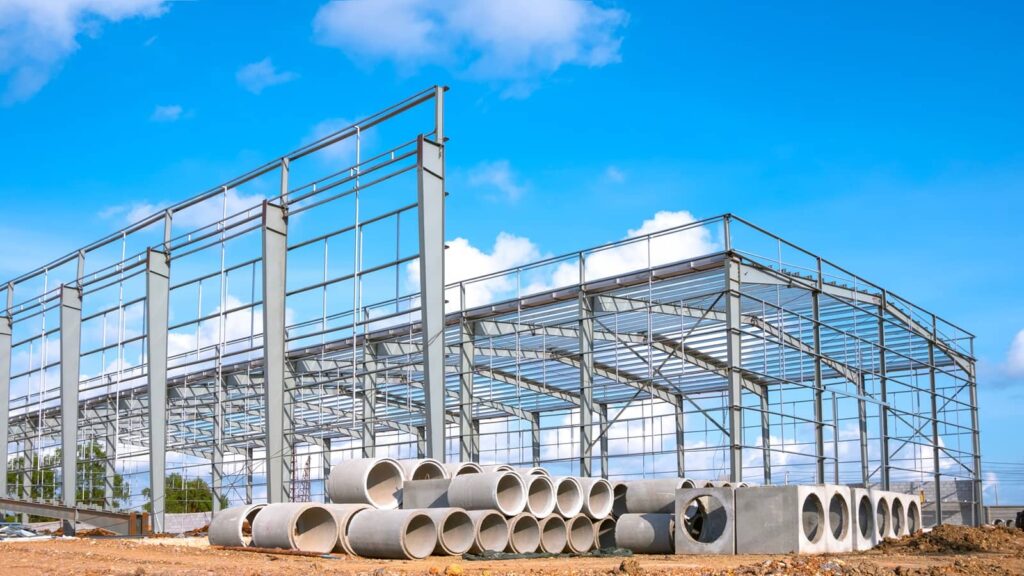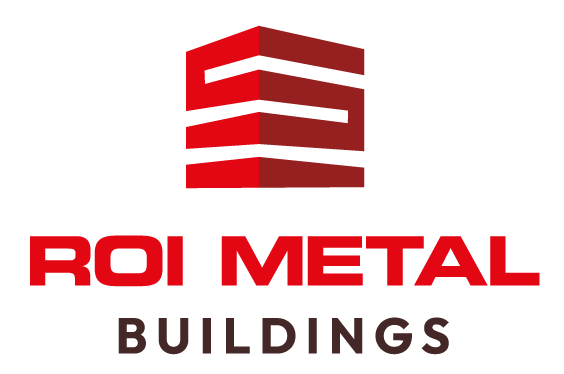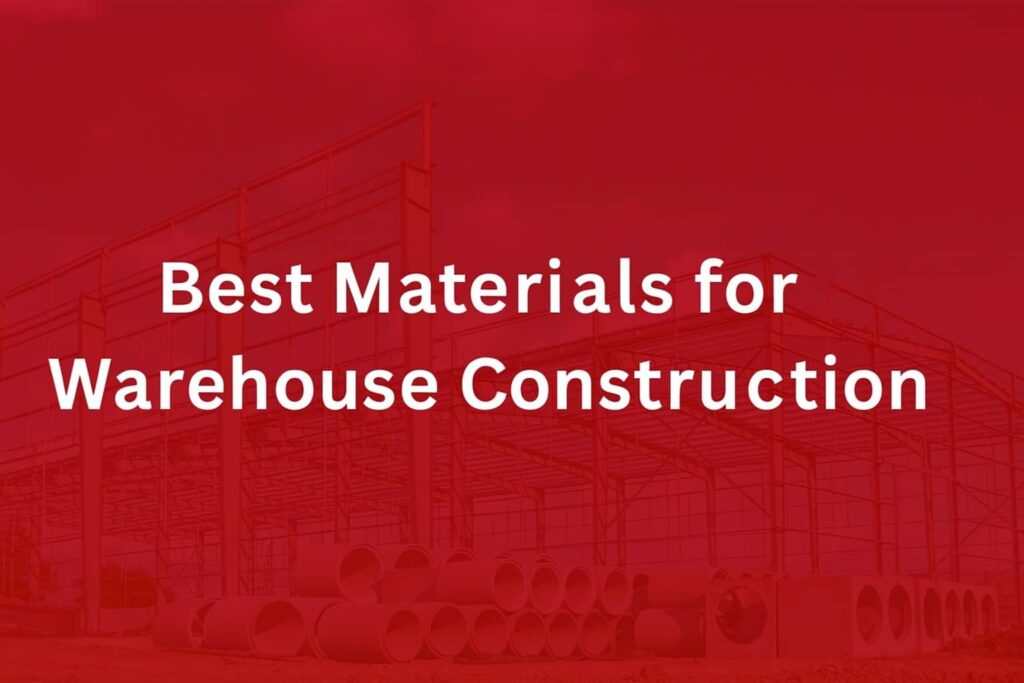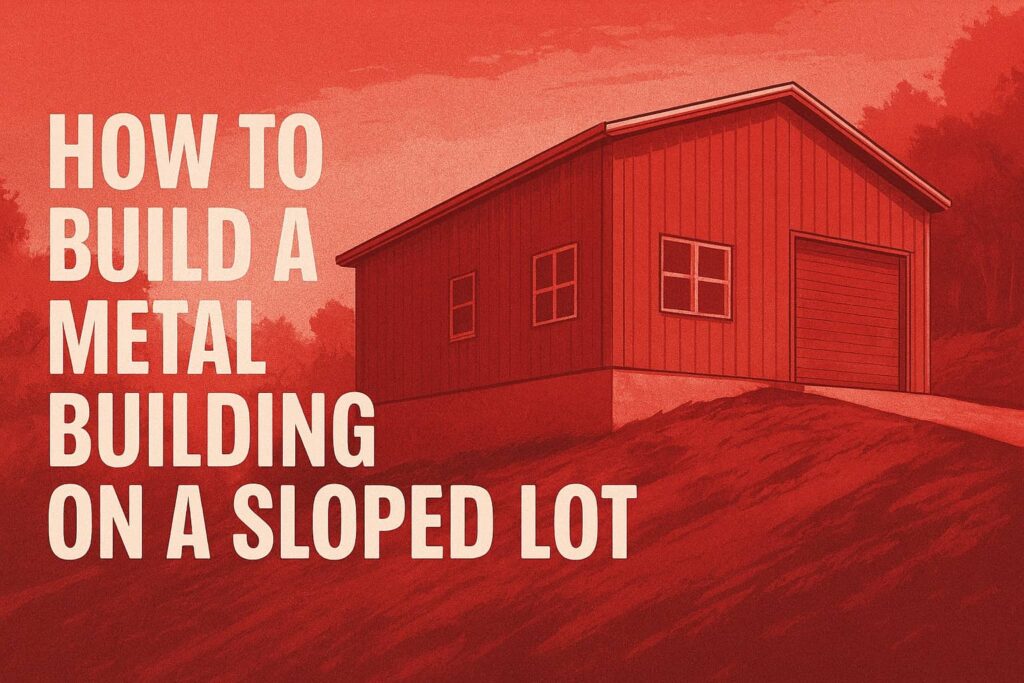When building a warehouse, the choice of materials is more than just about sturdiness; it directly influences efficiency and long-term costs. Many people may not realize this, but the right materials can transform a simple storage space into an operational powerhouse. For instance, opting for structural steel instead of wood or less durable alternatives doesn’t just enhance the integrity of the building; it can also lead to significant savings on maintenance and repairs down the road. This article aims to shed light on the best materials for warehouse construction that not only stand the test of time but also optimize functionality. By selecting high-quality options from roofs to windows, you can create a workspace that promotes productivity while keeping costs manageable. Let’s dive into the essential materials that make a successful warehouse!
The best materials for warehouse construction include structural steel for its strength and versatility, metal roofing for durability and low maintenance, concrete for foundations and flooring due to its ability to withstand heavy loads, insulation materials to regulate temperature, and energy-efficient doors and windows to enhance functionality. These choices ensure that the warehouse is resilient, efficient, and capable of meeting operational demands effectively.

Best Materials for Warehouse Construction
At the heart of warehouse construction, selecting the right structural steel can significantly impact the overall integrity of the building. This metal serves as the backbone framework, offering the necessary strength and stability to bear heavy loads. Unlike wood or traditional materials, structural steel is known for its durability, often lasting over 50 years without significant degradation. Beyond its impressive lifespan, it is also pest-resistant and fireproof, making it a smart choice for ensuring safety and longevity. Choosing the appropriate materials is essential to building a functional and durable warehouse.
Key Takeaways
- Concrete foundations and flooring deliver exceptional load-bearing capacity, evenly distributing weight to prevent settling and cracking; polished concrete adds durability, low maintenance, and thermal mass benefits for temperature regulation.
- Metal roofing offers long-term weather tightness and minimal upkeep, resisting corrosion and harsh conditions; it’s a cost-effective choice that outperforms built-up and TPO systems over decades.
- Insulation materials like fiberglass batts and foam board are affordable and highly effective, reducing energy costs, maintaining comfortable indoor climates, and boosting overall operational efficiency.
- Insulated sectional doors enhance security and climate control while allowing smooth forklift access; energy-efficient windows introduce natural light, cutting artificial lighting needs and improving workspace ambiance.
- Robust electrical infrastructure and strategically located outlets support diverse warehouse activities; LED lighting systems provide energy savings, meet safety requirements, and ensure reliable emergency illumination.
- A holistic material strategy, integrating concrete, metal roofing, insulation, openings, and electrical components, maximizes durability, energy performance, and long-term ROI.
Durable Structural Steel
Structural steel is fundamental to modern warehouse construction, acting as the backbone that ensures a robust and stable structure. Its immense strength and load-bearing capacity make it an ideal choice for warehouses where heavy inventories are common. You can imagine a warehouse filled to the brim with pallets of goods, machinery, or equipment; without durable structural support, this chaotic environment could lead to serious safety hazards. Thankfully, structural steel handles these situations beautifully. Steel is considered a durable option for warehouse construction due to its ability to withstand heavy use and environmental stress.
According to the American Institute of Steel Construction, steel is utilized in over 70% of commercial buildings because it dramatically enhances operational efficiency and provides durability for many years. With proper maintenance, the lifespan of structural steel can exceed 50 years, far longer than wood or concrete options, which struggle to endure harsh conditions and regular use. Steel is generally more affordable than concrete for large-scale warehouse projects, though initial costs may vary. This longevity reduces costs over time and contributes to a lower environmental impact by minimizing waste associated with frequent repairs and replacements. Using structural steel also helps minimize downtime by reducing the frequency of repairs and maintenance.
Advantages of Structural Steel
One of the standout benefits of structural steel is its resilience against extreme weather events. A study by the World Steel Association highlighted that structures made from steel can withstand earthquakes, hurricanes, and even heavy snow loads. For areas like Santo Domingo, which deal with coastal moisture and corrosion concerns, employing structural steel means securing your investment against nature’s unpredictable challenges.
Additionally, one cannot overlook the environmental advantages of using structural steel. At the end of its life cycle, steel can be completely recycled without losing any properties. This recyclability sets it apart from many other materials that contribute significantly to landfill waste when they no longer serve their purpose. Knowing that roughly 90% of scrap steel gets reused in new steel production makes it a more environmentally friendly option for responsible builders seeking sustainable solutions.
While structural steel provides an essential framework for durability and resilience in warehouse construction, the choice of roofing materials is critical for safeguarding what lies beneath. The next section will dive into roofing solutions that optimize performance while offering protection against environmental elements.
Efficient Roofing Options
Choosing the appropriate roofing material for your warehouse is more than just an aesthetic decision; it has direct implications for how well your building performs over time. A well-selected roof can significantly enhance energy efficiency by minimizing heat absorption in the summer and heat loss in the winter, which ultimately translates into lower utility bills. Moreover, focusing on durable materials ensures that your roof withstands the harshest elements while requiring less frequent maintenance. The most common types of warehouse roofing include metal, TPO membrane, and built-up roofing systems, each offering unique benefits and considerations for different operational needs.
Types of Roofing Materials
| Types of Roofing | Lifespan | Benefits |
|---|---|---|
| Metal Roofing | 40-70 years | Weather-resistant, low maintenance |
| TPO Membrane | 15-20 years | Energy-efficient, ideal for flat roofs |
| Built-Up Roofing | 20-30 years | Extremely durable, multi-layer protection |
For instance, metal roofing stands out as a premier choice known for its impressive lifespan and minimal upkeep requirements. While it does call for a larger initial investment compared to other options, this cost is often offset by its durability and energy-efficient qualities. Imagine a warehouse bustling with activity in a hot climate—here, metal roofs don’t just fend off the heat effectively; they also reflect sunlight away from the building, creating a cooler interior environment that reduces cooling costs markedly.
Consider another example: TPO (Thermoplastic Olefin) membrane roofing, often favored for flat-roof designs. This roofing type is lightweight yet robust, providing excellent insulation properties that help maintain a steady internal temperature. Beyond that, it’s particularly appealing for businesses looking to embrace sustainability; many TPO products are fully recyclable at the end of their life cycle.
The selection of roofing materials also ties directly into labor considerations. For instance, while metal roofing might require skilled contractors to install properly, adding to labor costs, its long-term performance can justify the upfront expense. Opting for easier-to-install materials may seem attractive initially but could lead to higher costs when replacement or repairs are needed sooner than anticipated.
Understanding these nuances in roofing options empowers warehouse owners to make informed decisions regarding their investments. Selecting quality materials is crucial in creating environments optimized for efficiency and longevity.
With this foundation laid on effective roofing choices, let’s shift focus towards another critical aspect of warehouse construction—the essential role that foundations play in supporting these structures.
Concrete Foundations and Floors
Concrete is indispensable in warehouse construction for foundations and flooring due to its robust properties. A well-constructed concrete foundation serves not just as a base but also plays a critical role in ensuring the stability of the entire structure. The right foundation allows for proper weight distribution, preventing the risk of settling or cracking, which could compromise the warehouse’s integrity. Concrete foundations offer greater resistance to soil movement compared to other types of foundations, making them a preferred choice for warehouses.
Uses of Concrete: Concrete foundations act like a sturdy bed beneath your warehouse, allowing it to grow strong and endure various loads over time. Creating a solid foundation is one of the first steps in ensuring that your investment lasts for years to come. It’s fascinating how something as straightforward as a concrete base can significantly enhance the longevity and efficiency of your operations. It’s really the unsung hero of warehouse construction.
In addition to foundations, concrete flooring is essential for any warehouse that deals with heavy vehicle traffic, think about all those forklifts and pallet jacks moving around daily. Polished concrete handles these weights well and requires minimal maintenance compared to other flooring options. According to data from The Concrete Institute, polished concrete floors are estimated to last more than 20 years, making them an economical choice for warehouses that prioritize durability.
For instance, consider a warehouse in Santo Domingo that chose concrete flooring specifically because of its long-lasting benefits, along with ease of cleaning, two key factors for managing heavy-duty operations effectively. By selecting polished concrete, they reduced the need for extensive upkeep while enhancing operational efficiency as their staff could quickly clean spills without worrying about damage.
Beyond durability, using high-strength concrete mixes for flooring can provide excellent performance under heavier loads expected in larger storage scenarios. Options like C40/50 mix offer extra compressive strength, translating into additional resilience, especially important in busy warehouses where maintaining productivity while ensuring safety is paramount.
Think about thickness recommendations; for example, light-duty warehouse floors can function effectively at 10 cm (about 4 inches), while medium and heavy-duty applications may require thicknesses of 15 cm (6 inches) up to 20 cm (8 inches). Careful consideration of both compressive strength and thickness directly correlates to the performance level you expect from your flooring.
While concrete provides the bedrock of the building, maintaining a controlled internal environment is equally essential for optimizing operational efficiency.
Insulation Choices for Energy Savings
The importance of insulation in warehouse construction cannot be overstated; it is essential for regulating temperature and minimizing energy costs. Effective insulation works by sealing gaps and preventing unwanted air exchange, which is crucial for maintaining energy efficiency. When considering warehouses, they often seem like vast spaces that are impossible to keep comfortable without overspending on heating and cooling. However, with the right insulation, this doesn’t have to be the case.
Types of Insulation
- Fiberglass: One of the most common insulation materials, fiberglass is affordable and surprisingly effective. With an R-value of approximately 3.5 per inch, it proves suitable for both wall and ceiling applications in warehouses.
- Foam Board: Offering a higher R-value per inch compared to fiberglass, foam board works wonders in tight or compact spaces where traditional batts simply won’t fit efficiently.
- Spray Foam: A favorite among building professionals, spray foam creates excellent air barrier properties and adheres beautifully to irregular surfaces. This ensures every nook and cranny is sealed against drafts.
Among these options, spray foam insulation stands out as particularly beneficial for warehouses located in hot climates. According to data from the Insulation Institute, spray foam can lead to savings of up to 50% in heating and cooling costs. This isn’t just a boastful number; it’s supported by significant research and countless testimonials from warehouse owners who experienced drastic reductions in their utility bills after adopting this method.
The environmental benefits of these insulation materials are equally compelling. For instance, using cellulose insulation, which has up to an 85% recycled content, can reduce carbon emissions by around 1,000 kg of CO2 per year. Such choices not only fulfill individual sustainability goals but also contribute positively towards combating global energy consumption challenges.
Implementing effective insulation is just one part of creating an efficient warehouse space that maximizes performance—there are also other critical elements to consider that enhance both functionality and energy efficiency.
Optimal Doors and Windows
Selecting the right doors and windows can significantly impact the overall functionality of a warehouse. High-quality doors and windows not only safeguard your assets but also enhance the thermal performance of the building. For example, steel roll-up doors are often favored due to their durability, making them ideal for high-traffic areas where heavy equipment operates. They’re known for their robustness and can withstand substantial wear and tear over time.
On the other hand, insulated sectional doors provide a dual benefit; they offer heightened security while also improving energy efficiency. Insulation serves as a barrier against temperature fluctuations, keeping the interior climate more consistent. This is particularly important in regions like Santo Domingo, where high ambient temperatures demand effective temperature control inside the warehouse.
Types of Doors and Windows
There are various options when it comes to choosing doors and windows that cater to your specific needs. For instance, energy-efficient windows can dramatically lower your utility expenses. According to Energy Star, these windows have the potential to reduce lighting and heating costs by up to 30%. Their design allows sufficient natural light into your workspace, minimizing reliance on artificial lighting during daylight hours. This not only saves money but also contributes to a better work environment.
“Natural light promotes better mood and productivity among employees.”
A real-world example highlights the effectiveness of installing energy-efficient windows: a warehouse in California witnessed a significant reduction in energy bills post-installation. Making such an investment can lead to substantial long-term savings on operating costs while creating a more pleasant atmosphere.
It’s clear that investing in quality doors and windows offers multifaceted benefits; however, the efficiency of operations extends beyond just structural elements. The integration of tailored systems for power distribution and illumination becomes essential.
Advanced Electrical and Lighting Solutions
Integrating modern electrical and lighting solutions into your warehouse can dramatically improve both efficiency and safety. As we move towards a more sustainable future, LED lighting stands out as an exemplary choice for warehouse settings. The benefits are substantial: LED lights are known to use at least 75% less energy than traditional incandescent bulbs, translating into significant cost savings on electricity bills. Furthermore, they can last up to 25 times longer, reducing the frequency of bulb replacements and the associated downtime, a key factor in keeping operations smooth.
Consider implementing motion sensors alongside LED lights for even greater efficiency. These sensors can automatically turn off lights when areas are unoccupied, ensuring energy isn’t wasted in sections of the warehouse where no work is currently happening. This dual approach maximizes both economic and environmental benefits while creating a safer workspace.
Aside from lighting, it’s also crucial to ensure that the electrical systems themselves are well-designed and maintained.
Advanced electrical systems should prioritize smart technology that allows for real-time monitoring and control. For instance, many companies now utilize IoT-enabled devices to manage energy consumption effectively. By tracking usage patterns, warehouse managers can adjust operations based on actual need rather than estimates—this enhances efficiency and further cuts operational costs.
An interesting case to note: several leading logistics firms have reported a noticeable boost in productivity after integrating smart electrical systems. The ability to automate various functions means workers can focus on their essential tasks rather than managing logistics manually.
With the growing trend towards automation in warehouses, enhancing your electrical infrastructure is not just beneficial—it’s vital. This includes investing in wiring capable of supporting sophisticated lighting solutions and technologies like robotic pickers or automated guided vehicles (AGVs). A properly designed electrical system ensures these advancements will operate smoothly without overloading circuits or reducing performance.
Regular maintenance of these electrical systems is equally important; neglecting this aspect can lead to costly repairs down the line.
Just like any investment, ensuring your advanced electrical solutions remain in top condition involves routine checks and updates. This includes inspecting wiring for wear and tear, testing circuit breakers, and ensuring that all installed LED fixtures are functioning efficiently. Through careful attention to these systems, you not only extend their lifespan but also guarantee the safety of your employees who rely on them daily.
By embracing energy-efficient lighting and modern electrical solutions within your warehouse framework, you’re not just optimizing functionality—you’re also contributing positively toward environmental sustainability while maximizing operational effectiveness. Emphasizing these aspects ensures that your warehouse remains an efficient hub for productivity in today’s ever-changing marketplace, making it easier than ever to stay ahead of the competition.
Low Maintenance Options
At our core, we believe that when it comes to warehouse roofing, your journey toward choosing low-maintenance options shouldn’t just be about minimizing downtime; it should be about empowering your business dreams and keeping your operating costs exactly where they belong. Our passion lies in guiding you toward insulated metal panels and single-ply roofing membranes that have become the cornerstone of outstanding durability and minimal maintenance requirements. We’ve dedicated ourselves to ensuring these materials are engineered not just to withstand the rigors of industrial environments, but to be your trusted partner in achieving excellent reflectivity and corrosion resistance that help extend the service life of your warehouse roof and turn your investment into something you’ll be proud of for years to come.
Our mission is clear: to make insulated metal panels not only provide robust protection against the elements but also contribute to your success through energy efficiency that reduces heat transfer and can significantly lower your energy costs throughout the year. We see a future where single-ply roofing membranes, such as TPO or PVC, become your pathway to warehouse roofing dreams. These smart choices for warehouses seeking low-maintenance solutions are designed with your prosperity in mind. These membranes resist UV radiation, temperature changes, and chemical exposure with unwavering commitment, ensuring your roofing system remains intact and effective with minimal upkeep, because your success is our success.
Our vision extends to applying acrylic coatings to your warehouse roof, a journey that can further enhance your facility’s energy efficiency and shield it from temperature fluctuations like a trusted guardian. We’re here to help these coatings create a seamless barrier that reflects sunlight, reduces heat absorption, and protects against corrosion, ultimately serving as your partner in reducing energy costs and prolonging the life expectancy of your roofing system. Through our expertise and commitment to your dreams, we transform simple coatings into powerful allies for your business.
We believe that by investing in low-maintenance roofing materials and systems with us as your guide, your warehouse can enjoy not just long-term durability, reduced maintenance demands, and lower operating costs, but a future where your facility remains protected and energy efficient for years to come. We’re not just providing roofing solutions; we’re your partner in turning your warehouse roofing vision into reality, ensuring every decision made is informed and every investment leads you toward the success you deserve.
Cost-Effective Solutions
At our core, we believe in a simple yet powerful vision: to transform warehouse construction through cost-effective solutions that balance quality with your budget constraints without compromise. Metal roofing, including our expertly recommended options like thermoplastic polyolefin (TPO) membranes and spray foam, stands as our cornerstone offering – a durable and affordable solution that we’ve dedicated ourselves to making accessible for every warehouse dream. These materials aren’t just engineered to handle heavy loads and resist pests; they’re our commitment to providing you with environmentally friendly and long-lasting choices that turn your warehouse vision into a profitable reality.
Our mission with TPO roofing is clear: to deliver a cost-effective pathway to achieving the highly durable and energy-efficient roof your warehouse deserves! We are passionate about TPO’s reflective surface because we know it will help regulate temperature inside your warehouse, reducing your cooling costs and contributing to the overall energy savings that make your investment sound. Spray foam represents another affordable solution in our arsenal – one that provides seamless insulation and waterproofing, further enhancing your building’s energy efficiency and reducing the maintenance burdens that can drain your resources over time.
When it comes to flooring solutions, we champion polished concrete as our standout cost-effective answer to your warehouse needs. We’re committed to delivering you a tough, low-maintenance surface that can withstand the constant movement of heavy equipment and foot traffic that defines successful warehouse operations. Our polished concrete floors aren’t just durable – they’re designed to be easy to clean, helping you minimize those ongoing maintenance expenses that can turn dreams into financial nightmares.
We aren’t just providers of materials and systems; we’re your partners in ensuring warehouses can keep upfront construction costs manageable while reducing long-term maintenance and operating expenses. Through our expertise and commitment to cost-effective solutions, we aim to ensure that your facility remains functional, efficient, and sustainable without compromising on quality or performance. Let us help turn your warehouse investment into something you will be proud of for years to come.
Warehouse Construction Considerations
Successful warehouse construction isn’t just about building – it’s about creating the foundation for your business success! At every step of your warehouse journey, we’re committed to ensuring that careful consideration of several key factors becomes your pathway to both unparalleled durability and exceptional energy efficiency. Your climate, budget, and the specific operational needs of your facility aren’t just considerations – they’re the cornerstones of our material and system selection process, designed to make your investment profitable and sustainable. For instance, when your warehouse is located in regions with high temperatures, we ensure you get the additional insulation needed to regulate temperature and slash those heating costs, directly transforming your building’s energy efficiency and service life into long-term profitability.
The choice of roofing material becomes your competitive advantage when you partner with us. Materials like steel, concrete, and wood aren’t just options – they’re strategic decisions that we’ll guide you through, each offering unique advantages tailored to your success. Steel stands as the champion of durability and strength, making it our go-to recommendation for warehouse construction that lasts, while concrete delivers that excellent load-bearing capacity and thermal mass your operation demands. Wood, though less common in industrial settings, can become your cost-effective solution for certain applications, and we’ll be transparent about the maintenance considerations to ensure your investment remains sound over time.
Insulation isn’t just essential – it’s your secret weapon for maintaining that stable internal environment and minimizing energy costs that impact your bottom line. By partnering with us to select the right combination of materials and systems, your warehouse transforms into a facility that’s not just cost-effective but perfectly tailored to your specific needs and designed for maximum profitability.
Ultimately, when you take the time to evaluate these factors with our expert guidance – climate, budget, material properties, and operational requirements – you’re not just building a warehouse, you’re creating a lasting investment that operates efficiently and delivers the best possible return. Your success in warehouse construction is our success, and we’re here to ensure your building dreams become a profitable reality that you’ll be proud of for years to come.
Benefits of Proper Construction
At our core, we understand that the benefits of proper construction are the foundation of your warehouse facility’s success. When we partner with you to build a well-constructed warehouse, we’re not just minimizing your risk of structural damage – we’re maximizing your potential for reduced energy costs and creating the safe, efficient working environment your business deserves. Our commitment to proper installation of roofing materials, insulation, and flooring is your shield against common issues such as cracks, corrosion, and equipment damage, ensuring you avoid those costly repairs and operational disruptions that can derail your success.
Through our focus on durable and energy-efficient materials, we help your warehouse significantly reduce operating costs while extending the service life of your building investment. For example, when we recommend high-quality roofing materials and insulation, we’re helping you maintain consistent internal temperatures that translate directly into lower energy costs and minimal downtime due to maintenance or repairs. Additionally, our robust flooring systems don’t just prevent damage from heavy equipment – they safeguard your facility’s productivity and protect your bottom line.
Your investment in proper construction practices with us as your partner doesn’t just ensure a long and trouble-free service life for your warehouse – it enhances your overall operational efficiency and positions your business for the long-term success you envision. This proactive approach we champion together protects your investment, supports your employee safety, and ensures your venture into warehouse operations becomes something you’ll be proud of for years to come.
Construction Best Practices
At our core, we believe that adhering to construction best practices is the cornerstone of every successful warehouse journey. When we partner with you to create your facility, our commitment centers on careful consideration of your budget, materials, and systems, ensuring we build not just a warehouse, but a foundation for your operational dreams to become reality. Together, we focus on meeting your specific needs while keeping your investment both cost-effective and energy-efficient, because your success is our success.
We’re passionate about utilizing high-quality materials that truly serve your vision, like insulated metal panels and single-ply roofing membranes that we know will provide you with a durable and energy-efficient roofing system featuring excellent corrosion resistance. These aren’t just materials to us; they’re the building blocks of your success story. We choose materials designed to withstand harsh industrial environments and require minimal maintenance, helping you reduce energy costs and extend your facility’s lifespan, because we’re invested in your long-term prosperity.
Our commitment to your success doesn’t end at construction; we believe regular maintenance and inspections are where true partnership shines. By working together to proactively identify and address potential issues, such as leaks, corrosion, or insulation gaps, we help you prevent minor concerns from escalating into major repairs. This approach isn’t just about protecting your building’s integrity; it’s about minimizing your downtime and ensuring your operation runs smoothly, because when you thrive, we thrive.
Additionally, we’re dedicated to considering every factor that matters to your success, like reflectivity, corrosion resistance, and thermal performance, when we guide you through selecting materials and systems. This ensures your warehouse is equipped to handle its unique challenges with confidence. By following these construction best practices together, we create more than just a building; we create a safe, productive, and cost-effective environment that supports your long-term operational success and turns your warehouse vision into a profitable reality.
For expert advice on crafting an efficient warehouse, contact us at ROI Metal Buildings or call us at 865-316-9009 today!




